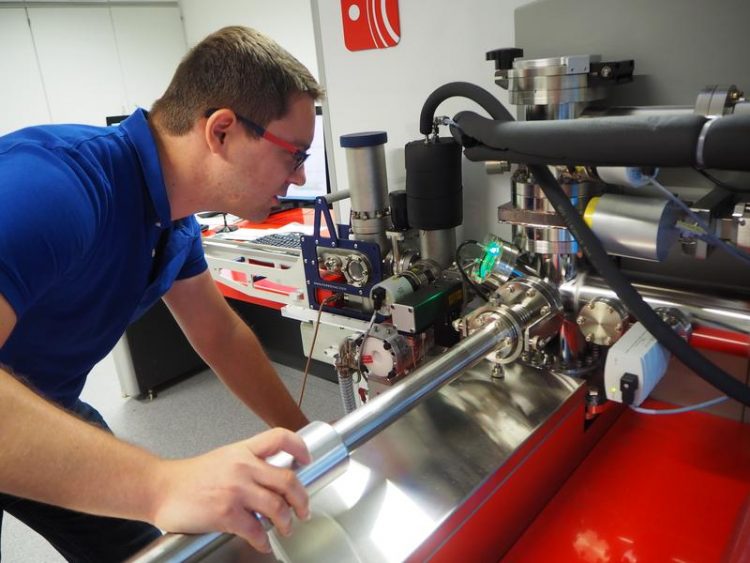The role of Sodium for the Enhancement of Solar Cells

Dr. Torsten Schwarz, postdoctoral researcher at the MPIE, analyzed the local clustering and gradients of sodium with the atom probe (seen in the image). Max-Planck-Institut für Eisenforschung GmbH
Green energy gained by photovoltaic amounts ca. 6% of Germany’s gross power production . The most common solar cells currently used are made out of silicon. So-called CIGS, solar cells out of copper, indium, gallium and selen (Cu(In,Ga)(S,Se)2, are a promising alternative with an efficiency of ca. 23%, which is the conversion rate of light to electricity.
In comparison to conventional silicon solar cells, CIGS consumes less material and production energy and are thus cheaper in production and environmentally friendly. Nevertheless, silicon solar cells are still more often used due to their high reliability. Dr. Torsten Schwarz, postdoctoral researcher at the Max-Planck-Institut für Eisenforschung (MPIE) in Düsseldorf, and a team out of researchers mainly from the University of Luxembourg and the MPIE, investigated the influence of sodium doping on the growth and reliability of CIGS. The researchers published their latest findings in the journal Nature Communications.
Previous research showed that sodium increases the CIGS’s efficiency but at the same time hampers the interdiffusion of indium and gallium so that a controlled growth of the solar cell is difficult. But how does sodium influence the cell at a grain boundary and what does it do in a grain itself?
To ease the complexity of CIGS the researchers worked with monocrystalline instead of polycrystalline films. They compared the interdiffusion between the gallium-free crystal and the gallium-containing substrate with and without sodium. “We could show that sodium increases the interdiffusion of indium and gallium in monocrystalline films. The same is true for polycrystalline films but the effect takes place within a grain and not between grains, i.e. not across grain boundaries.
This means that CIGS doped with sodium experiences an enhanced indium-gallium interdiffusion and are one reason why these films are more efficient”, explains Schwarz, who mainly did atom probe tomography measurements (APT) to reveal the local clustering and gradients of sodium. These findings were also confirmed by transmission electron microscopy (TEM) analysis done by Schwarz and his colleague Dr. Alba Garzón Manjón, also postdoctoral researcher at the MPIE.
Additionally, the effect of sodium on the diffusion of gallium from the substrate through the film was measured by secondary ion mass spectrometry, energy-dispersive X-ray spectroscopy and cross-sectional nano-Auger electron spectroscopy, which were coordinated by the University of Luxembourg. The results add new experimental data on the effects of sodium doping in CIGS and give insight into the interdiffusion of indium and gallium.
The analysis revealed that sodium promotes indium and gallium intragrain diffusion and at the same time hinders diffusion across grain boundaries. Thus, grain boundaries play an important role as they act as a barrier for intergrain diffusion in conventional polycrystalline CIGS films. Through grain boundary engineering and a better control of gallium diffusion the efficiency of solar cells can be increased. The researchers aim at improving and decreasing costs for future CIGS photovoltaic technologies through a better understanding of these fundamental processes. Moreover, in September Schwarz will present newest findings on potassium doping at the International Microscopy Conference IMC19 in Sydney, Australia.
D. Colombara, F. Werner, T. Schwarz et al: Sodium enhances indium-gallium interdiffusion in copper indium gallium diselenide photovoltaic absorbers. In: Nature Communications, (2018) 9:826 , DOI: 10.1038/s41467-018-03115-0
Media Contact
All latest news from the category: Power and Electrical Engineering
This topic covers issues related to energy generation, conversion, transportation and consumption and how the industry is addressing the challenge of energy efficiency in general.
innovations-report provides in-depth and informative reports and articles on subjects ranging from wind energy, fuel cell technology, solar energy, geothermal energy, petroleum, gas, nuclear engineering, alternative energy and energy efficiency to fusion, hydrogen and superconductor technologies.
Newest articles

A universal framework for spatial biology
SpatialData is a freely accessible tool to unify and integrate data from different omics technologies accounting for spatial information, which can provide holistic insights into health and disease. Biological processes…

How complex biological processes arise
A $20 million grant from the U.S. National Science Foundation (NSF) will support the establishment and operation of the National Synthesis Center for Emergence in the Molecular and Cellular Sciences (NCEMS) at…

Airborne single-photon lidar system achieves high-resolution 3D imaging
Compact, low-power system opens doors for photon-efficient drone and satellite-based environmental monitoring and mapping. Researchers have developed a compact and lightweight single-photon airborne lidar system that can acquire high-resolution 3D…





















